System Image Flashing
1. Overview
LuckFox Pico Pro/Max comes preloaded with a factory test image on its built-in SPI NAND Flash to facilitate functionality testing during production. For actual use, users must manually flash the operating system either to the onboard Flash or to a TF card to ensure the system boots and runs properly.
2. Driver Installation
- Download the RK DriverAssitant(click here to download).
- Open the RK Driver Assistant to install the USB driver. There is no need to connect during this process. After the installation is complete, restart the computer.
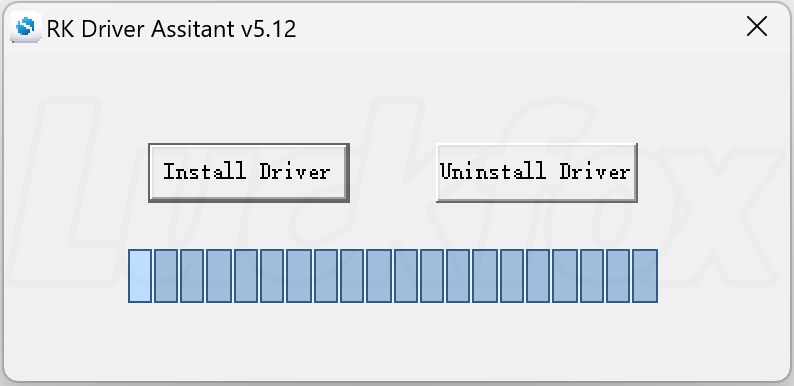
3. Image Download
Officially Supported Image Download
The Luckfox Pico Pro/Max series provides images based on Buildroot. Users can download the image files according to their needs.
| Version | Description | Download |
|---|---|---|
| Buildroot | Luckfox Pico Pro: Flash Luckfox_Pico_Pro_MicroSD_250313 or Luckfox_Pico_Pro_Flash_250313 firmware LLuckfox Pico Max: Flash Luckfox_Pico_Max_MicroSD_250313 or Luckfox_Pico_Plus_Flash_250313 firmware | Google Driver |
Community-Supported Image Download
| Version | Description | Download |
|---|---|---|
| Ubuntu22.04 | Luckfox Pico Pro: Flash Ubuntu_Luckfox_Pico_Pro_MicroSD_250313 firmware Luckfox Pico Max: Flash Ubuntu_Luckfox_Pico_Max_MicroSD_250313 firmware | Google Driver |
Please ensure you flash the latest image version. The example image Luckfox_Pico_Pro_Flash_250313 (where 250313 indicates the image date) may not be the most recent version.
4. Flashing the Image (Windows Environment)
The SocToolKit software supports two flashing modes for eMMC or Flash:
One-click full image flashing: This mode uses a pre-packaged full system image containing all required partitions. It is suitable for rapid deployment and enables quick system setup.
Selective partition flashing: This allows updating specific system modules, offering a flexible flashing solution for users with advanced customization needs.
- These two flashing modes are independent. Choose the one that fits your needs — only one is required during the actual operation.
- If the development board is successfully connected via ADB, you can directly execute the command
reboot loaderto quickly enter flashing mode without manually pressing any buttons.
4.1 Flashing Image to SPI NAND Flash
- Download and extract the SocToolKit flashing tool(Click here to download).
- Open the software(right-click and run as administrator),then select RV1106.

- Device connection and partition image flashing:
① While holding down the BOOT button, connect the board to your PC. Release the BOOT button once the Rockchip flashing tool displays aMaskRomdevice (device number may vary).
② Click Search Path to select the firmware directory, check all the partitions you want to flash, then click the Download button to start flashing.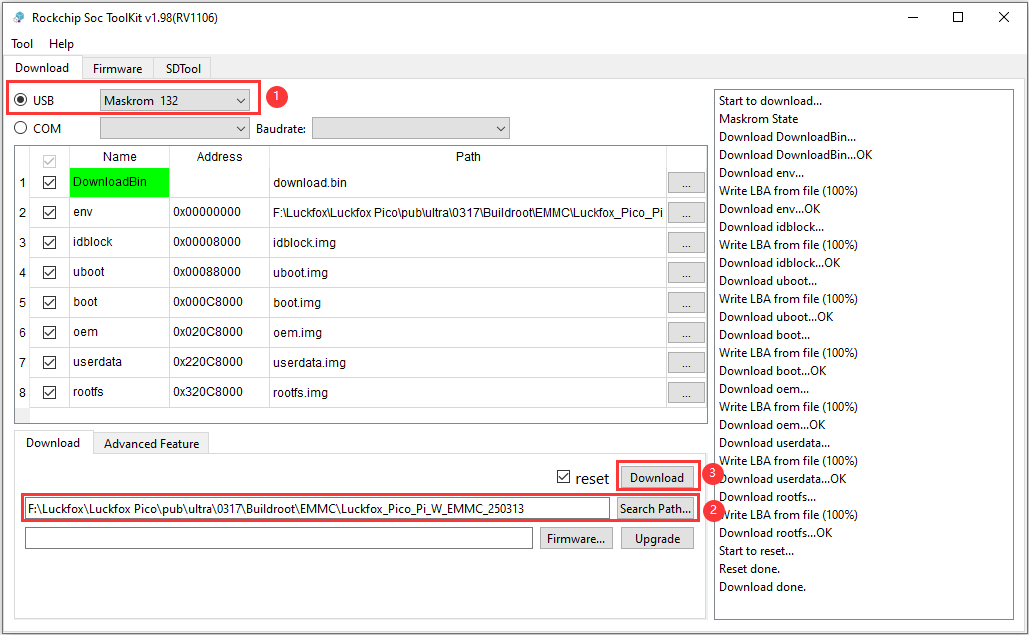
- Device connection and one-click full image flashing:
① While holding down the BOOT button, connect the board to your PC. Release the BOOT button once the Rockchip flashing tool displays aMaskRomdevice (device number may vary).
② Click Firmware to select the firmware directory, then click the Upgrade button to start flashing.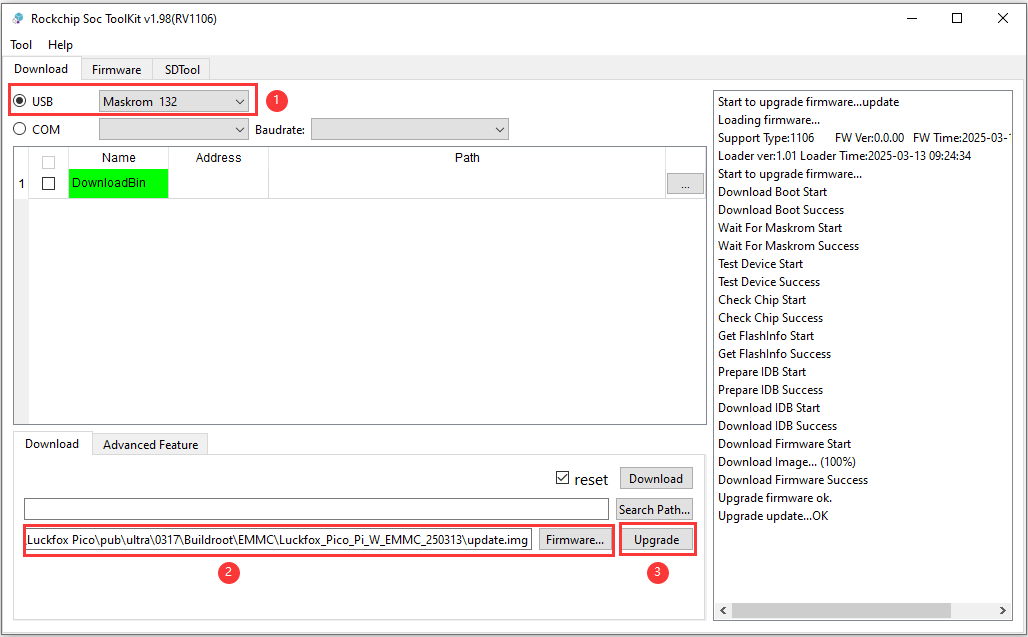
4.2 Flashing Image to TF Card
The SD card flashing feature of the SocToolKit software only supports one-click image flashing.
- Download the TF card formatting tool SD Card Formatter, unzip and install with one click.( Click here to download ).
- Select the correct TF card drive letter and click "Format". Make sure to remove any other TF cards to avoid accidental data loss.

- Download and extract the SocToolKit flashing tool.( Click here to download ).
- Open the software(Run as Administrator), then choose RV1106.

- Follow these flashing steps:
① Launch the SocToolKit tool and switch to SDTool mode.
② Insert the TF card into a reader and connect it to your PC. The SD card capacity should now be visible under USB drives.
③ Select SD Card Boot.
④ Import the boot files.(Note: The boot files do not include update.img)
⑤ Click Create SD Card to begin the flashing process.。
- If the MicroSD card is not recognized, please re-run the software with administrator privileges.
- The bootable image does not contain update.img.
5. Image Flashing (Linux Environment)
- Currently supported only on Ubuntu 22.04 x86_64. Other platforms or architectures are not compatible at this time.
- upgrade_tool is a closed-source command-line flashing utility provided by Rockchip, supporting only SPI NAND Flash and eMMC as target storage media.
5.1 Flashing Image to SPI NAND Flash
5.1.1 Entering Flash Mode on the Development Board
Press and hold the BOOT button while connecting the board to the host PC to enter flash mode.
After running the lsusb command, you can compare the device recognition results between flash mode and normal operating mode, as shown below:
- Board in flash mode:

- Board successfully booted into the system:

If the virtual machine cannot recognize the board, it is usually caused by one of the following reasons:
- Faulty USB cable: If replugging the cable causes no response and no system or VMware popup appears, the cable is likely damaged or has a poor connection. Try replacing the USB cable and reconnecting the board.
- Device not assigned in VMware popup: When plugging in the board, VMware will prompt you to choose whether to connect the device to the “Host” or “Virtual Machine.”
If no selection is made before the popup disappears and VMware’s auto-connect policy is not properly configured, the device remains unassigned, meaning it is neither controlled by the host nor mounted to the VM.
In this case, replug the device to reassign control.
5.1.2 Flashing Standalone Image (Without SDK)
Download, extract, and install upgrade_tool :
sudo unzip upgrade_tool_v2.17.zip
cd upgrade_tool_v2.17_for_linux/
sudo cp upgrade_tool /usr/local/bin
sudo chmod +x /usr/local/bin/upgrade_toolVerify installation success:
ubuntu@ubuntu:~$ sudo upgrade_tool -v
Upgrade Tool v2.17Run the tool to flash the firmware:
luckfox@luckfox:~$ sudo upgrade_tool uf update.img
Loading firmware...
Support Type:1106 FW Ver:0.0.00 FW Time:2023-11-16 16:24:18
Loader ver:1.01 Loader Time:2023-11-16 16:22:58
Start to upgrade firmware...
Download Boot Start
Download Boot Success
Wait For Maskrom Start
Wait For Maskrom Success
Test Device Start
Test Device Success
Check Chip Start
Check Chip Success
Get FlashInfo Start
Get FlashInfo Success
Prepare IDB Start
Prepare IDB Success
Download IDB Start
Download IDB Success
Download Firmware Start
Download Image... (100%)
Download Firmware Success
Upgrade firmware ok.Result preview:
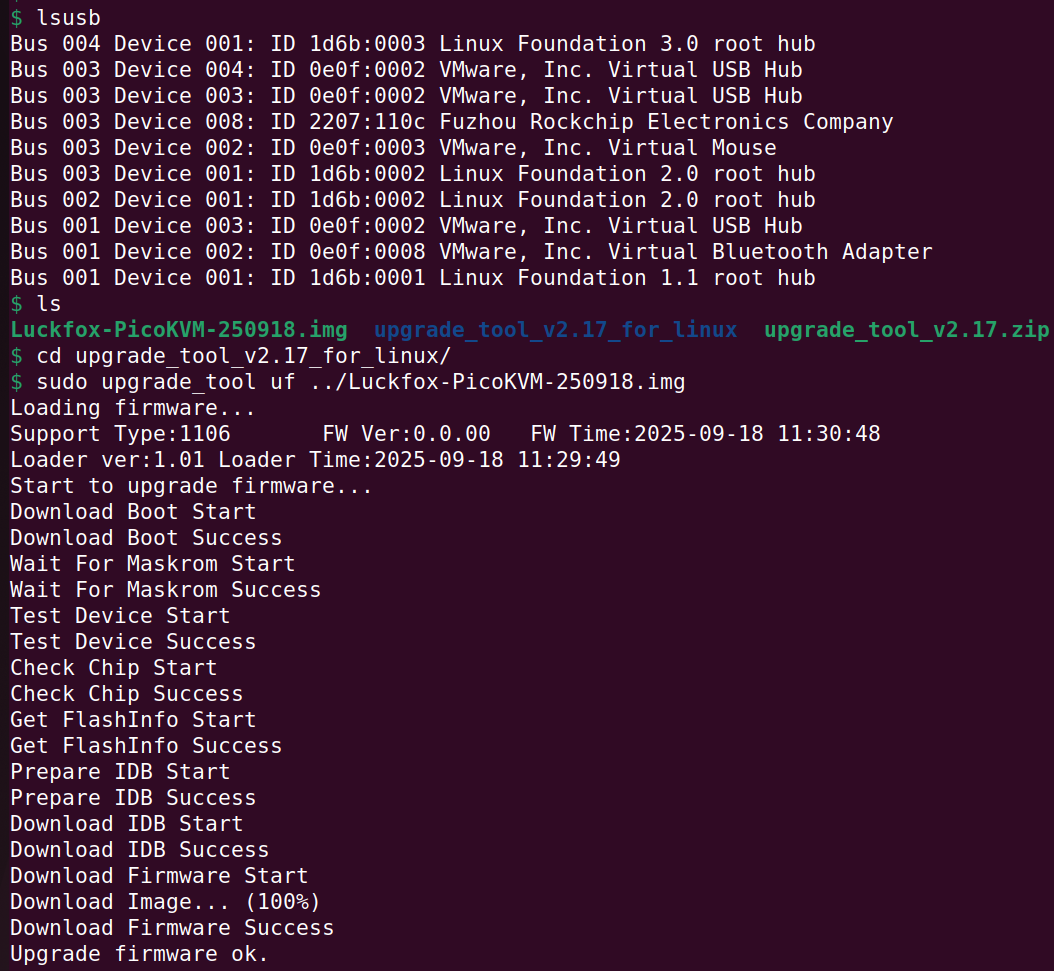
5.1.2 Flashing the Image via SDK Script
The output/image directory must contain the update.img file, which is automatically generated when compiling the SDK. If you have not compiled the SDK yet, manually create the output/image directory and place the downloaded firmware inside it, renaming the file to update.img.
- Ensure the board is in flash mode before proceeding.
- Run the flashing script with administrator privileges:
$ sudo ./rkflash.sh update
[sudo] password for ubuntu:
Using /home/ubuntu/Luckfox/ubuntu-bluetooth/luckfox-pico/tools/linux/Linux_Upgrade_Tool/config.ini
Loading firmware...
Support Type:1106 FW Ver:0.0.00 FW Time:2024-09-27 14:22:59
Loader ver:1.01 Loader Time:2024-09-27 14:17:09
Start to upgrade firmware...
Download Boot Start
Download Boot Success
Wait For Maskrom Start
Wait For Maskrom Success
Test Device Start
Test Device Success
Check Chip Start
Check Chip Success
Get FlashInfo Start
Get FlashInfo Success
Prepare IDB Start
Prepare IDB Success
Download IDB Start
Download IDB Success
Download Firmware Start
Download Image... (100%)
Download Firmware Success
Upgrade firmware ok - Result preview:

5.2 Flashing Image to TF Card
Original script source: https://gist.github.com/Spiritdude/da36 ... 0a8b9f972f
Download the script file blkenvflash.
Compare the device list on the Ubuntu PC before and after inserting the SD card to determine that the SD card corresponds to the device
/dev/sdb.
Copy the script file to the directory of the SD card image and give the script executable permission.
chmod +x blkenvflashFlash the image, and when the terminal prints "done," it indicates that the image has been successfully written.

In Ubuntu 24.04 (Python 3.12.3), a SyntaxWarning may appear, while this warning does not occur in Ubuntu 22.04 (Python 3.10.12). This is due to stricter checks introduced in Python 3.12 regarding invalid escape sequences in regular expressions. The warning does not affect the image flashing. To eliminate the warning, add an r before the string in the regular expression to make it a raw string. This way, escape characters like \d and \w will not be interpreted as regular escape sequences.
6. Flashing Image in macOS Environment
The upgrade_tool is available for both Linux and macOS platforms.
Only SPI NAND Flash flashing is supported on macOS.To flash firmware to a TF card, please use a Windows or Linux environment.
- Download and extract the Upgrade_Tool flashing tool(Click here to download).
- Run the system_profiler SPUSBDataType command to check whether the development board is correctly detected by the system.
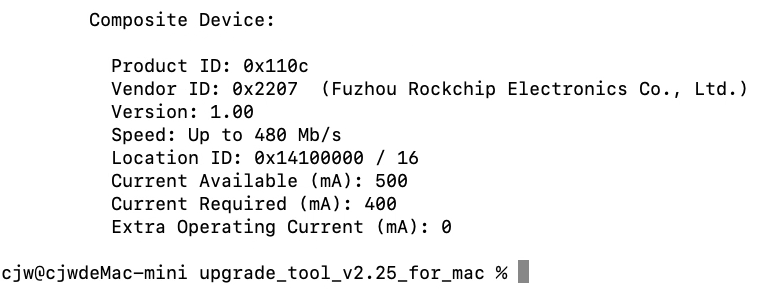
- Run the tool to flash the firmware (please modify the path according to the actual location of your image):
$ cd upgrade_tool_v2.44_mac
sudo ./upgrade_tool uf Luckfox-xxx-xxx.img - The expected output is as follows:
